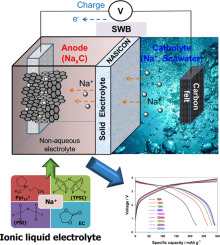Large-scale Stationary Energy Storage: Seawater Batteries with High Rate and Reversible Performance
- Journal
- Energy Storage Materials
- Vol
- 16
- Page
- 56-64
- Year
- 2019
A new electrolyte (anolyte) for the negative electrode of seawater batteries, based on the combination of two ionic liquids (ILs), a sodium salt, and a SEI-forming additive, is herein reported. The quaternary anolyte is composed of N-methyl-N-propylpyrrolidinium bis(fluorosulfonyl)imide (0.6 mol fraction), N-methyl-N-propylpyrrolidinium bis(trifluoromethanesulfonyl) imide) (0.3 mol fraction), and sodium bis(fluorosulfonyl)imide (0.1 mol fraction). Ethylene carbonate (5 wt% with respect to the ILs and salt mixture) is added to promote SEI formation. The thermal, physicochemical, and electrochemical characterization of the quaternary electrolyte indicate its suitability as an anolyte, as well as the formation of a highly stable interface with the negative (hard carbon) electrode. Lab-scale seawater full cells employing a hard carbon anode and the ionic liquid-based quaternary anolyte show remarkable results in terms of capacity, cyclability, and rate capability at room temperature. Additionally, these cells showed better energy efficiency (voltage efficiency) and cyclability than those based on a conventional organic carbonate-based anolyte.

